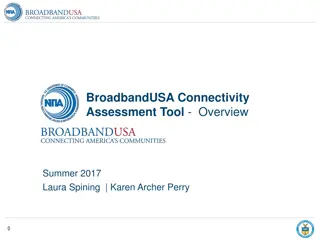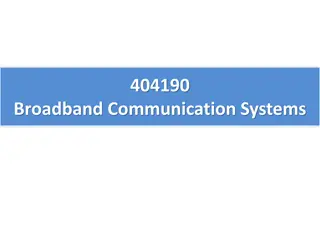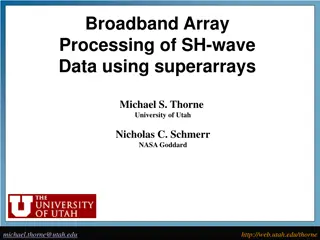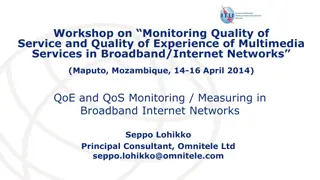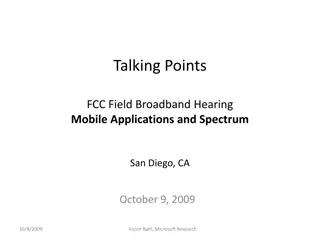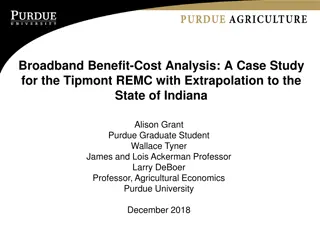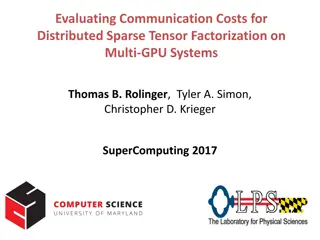Understanding Multiband Systems in Broadband Communication
Explore the world of Wavelength Division Multiplexing (WDM) and its components, including fiber couplers, isolators, circulators, multiplexers, and demultiplexers. Learn the benefits of WDM technology such as capacity upgrade, transparency, scalability, and wavelength routing. Discover how WDM, CWDM, and DWDM technologies revolutionize data transmission over fiber optics with their unique channel spacing. Dive into the details of DWDM systems utilizing multiple wavelengths for high-capacity data transmission.
- Broadband Communication
- Wavelength Division Multiplexing
- Fiber Optics
- DWDM Technology
- Data Transmission
Download Presentation

Please find below an Image/Link to download the presentation.
The content on the website is provided AS IS for your information and personal use only. It may not be sold, licensed, or shared on other websites without obtaining consent from the author. Download presentation by click this link. If you encounter any issues during the download, it is possible that the publisher has removed the file from their server.
E N D
Presentation Transcript
Broadband Communication Systems UNIT-III Multiband Systems Dr. Achala Deshmukh achala.deshmukh@gmail.com amdeshmukh.scoe@sinhgad.edu 9422319006
UNIT:III Contents Ref. Topic Overview of WDM T1 10.1 WDM Components: 2x2 Fiber Coupler, Optical Isolators and Circulators, Multiplexers and De- multiplexers, Fiber Bragg Grating T1 10.2.1 10.3 8.2.2 10.4.1 R1 T1 FBG Applications for multiplexing and De- multiplexing Function T1 10.4.3 Diffraction Grating Senior 5.6.3 Overview of Optical Amplifiers SOA, EDFA and RA in Brief R1 6 (Short Notes) 2
WDM Concept and Components
Why WDM? Capacity upgrade of existing fiber networks (without adding fibers) Transparency: Each optical channel can carry any transmission format (different asynchronous bit rates, analog or digital) Scalability Buy and install equipment for additional demand as needed Wavelength routing and switching: Wavelength is used as another dimension to time and space 10/8/2024 4
Wavelength Division Multiplexing Each wavelength is like a separate channel (fiber) 10/8/2024 5
Wavelength Division Multiplexing Passive/active devices are needed to combine, distribute, isolate and amplify optical power at different wavelengths 10/8/2024 6
WDM, CWDM and DWDM WDM technology uses multiple wavelengths to transmit information over a single fiber Coarse WDM (CWDM) has wider channel spacing (20 nm) low cost Dense WDM (DWDM) has dense channel spacing (0.8 nm) which allows simultaneous transmission of 16+ wavelengths high capacity 10/8/2024 7
WDM and DWDM First WDM networks used just two wavelengths, 1310 nm and 1550 nm Today's DWDM systems utilize 16, 32,64,128 or more wavelengths in the 1550 nm window Each of these wavelength provide an independent channel (Ex: each may transmit 10 Gb/s digital or SCMA analog) The range of standardized channel grids includes 50, 100, 200 and 1000 GHz spacing Wavelength spacing practically depends on: laser linewidth optical filter bandwidth 10/8/2024 8
ITU-T Standard Transmission DWDM windows c = 2 10/8/2024 9
Principles of DWDM BW of a modulated laser: 10-50 MHz 0.001 nm Typical Guard band: 0.4 1.6 nm 80 nm or 14 THz @1300 nm band 120 nm or 15 THz @ 1550 nm Discrete wavelengths form individual channels that can be modulated, routed and switched individually These operations require variety of passive and active devices = c Ex. 10.1 2 10/8/2024 10
Nortel OPTERA 640 System 64 wavelengths each carrying 10 Gb/s 10/8/2024 11
Key Components for WDM Passive Optical Components Wavelength Selective Splitters Wavelength Selective Couplers Active Optical Components Tunable Optical Filter Tunable Source Optical amplifier Add-drop Multiplexer and De-multiplexer 10/8/2024 12
Passive Devices These operate completely in the optical domain (no O/E conversion) and does not need electrical power Split/combine light stream Ex: N X N couplers, power splitters, power taps and star couplers Technologies: - Fiber based or Optical waveguides based Micro (Nano) optics based Fabricated using optical fiber or waveguide (with special material like InP, LiNbO3) 10/8/2024 13
Filter, Multiplexer and Router 10/8/2024 14
Basic Star Coupler May have N inputs and M outputs Can be wavelength selective/nonselective Up to N =M = 64, typically N, M < 10 10/8/2024 15
Fused-Biconical coupler OR Directional coupler P3, P4 extremely low ( -70 dB below Po) Coupling / Splitting Ratio = P2/(P1+P2) If P1=P2 It is called 3-dB coupler 10/8/2024 16
Definitions + Splitting (Coupling) Rat i o = ( ) P P P 2 1 2 + Excess Lo ss =10 Log [ ( ) ] P P P 0 1 2 In sert ion Loss =1 0 Log[ ] P P in out Crosstalk = 10 Lo g(P P ) 3 0 Try Ex. 10.2 10/8/2024 17
Coupler Characteristics power ratio between both output can be changed by adjusting the draw length of a simple fused fiber coupler It can be made a WDM de-multiplexer: Example, 1300 nm will appear output 2 (p2) and 1550 nm will appear at output 1 (P1) However, suitable only for few wavelengths that are far apart, not good for DWDM 10/8/2024 18
Wavelength Selective Devices These perform their operation on the incoming optical signal as a function of the wavelength Examples: Wavelength add/drop multiplexers Wavelength selective optical combiners/splitters Wavelength selective switches and routers 10/8/2024 19
Fused-Fiber Star Coupler Splitting Loss = -10 Log(1/N) dB = 10 Log (N) dB Excess Loss = 10 Log (Total Pin/Total Pout) Fused couplers have high excess loss 10/8/2024 20
8x8 bi-directional star coupler by cascading 3 stages of 3-dB Couplers 1, 2 1, 2 5, 6 1, 2 3, 4 7, 8 N 2 (12 = 4 X 3) Try Ex. 10.5 Number of 3-dB Cou plers N = log N c 2 10/8/2024 21
Fiber Brag Grating (FBG) Basic FBG is an in-fiber passive optical band reject filter FBG is created by imprinting a periodic perturbation in the fiber core The spacing between two adjacent slits is called the pitch Grating play an important role in: Wavelength filtering Dispersion compensation Optical sensing EDFA Gain flattening Single mode lasers and many more areas 10/8/2024 23
Bragg Grating formation = 2 sin( ) 2 / uv 10/8/2024 24
FBG Theory Exposure to the high intensity UV radiation changes the fiber core n(z) permanently as a periodic function of z 1 [ ) ( + = n n z n core + cos( 2 / )] z Distance measured along fiber core axis Pitch of the grating z: : ncore: Core refractive index n: Peak refractive index
Reflection at FBG 10/8/2024 26
Simple De-multiplexing Function = Reflected Wavelength 2 n B eff Peak Reflectivity Rmax = tanh2(kL) 10/8/2024 27
ADD/DROP MUX FBG Reflects in both directions; it is bidirectional
FBG Properties Advantages Easy to manufacture, low cost, ease of coupling Minimal insertion losses approx. 0.1 db or less Passive devices Disadvantages Sensitive to temperature and strain. Any change in temperature or strain in a FBG causes the grating period and/or the effective refractive index to change, which causes the Bragg wavelength to change. = T neff neff + neff T
10/8/2024 31
10/8/2024 32
10/8/2024 33
Why Optical Amplifiers? Increase transmission distance by increasing optical power coupled to transmission fiber(power booster) by compensating optical fiber losses(in-line amplifier, remote pump amplifier) by improving receiver sensitivity (optical preamplifier) Function : Amplification of optical signal without conversion to electrical signal Ingredients : Pump energy, amplification medium Optical output Pumping of energy Optical input ... amplification medium ... 1 2 3 4 5 7 8 6 16 35
General Application of Optical Amplification In-line amplifier Preamplifier Power (booster) amplifier LAN booster amplifier Amplifier Standard Fiber Pump Lasers 36
Erbium Doped Fiber Amplifiers (EDFA)
Basic EDF Amplifier Design Erbium-doped fiber amplifier (EDFA) most common Commercially available since the early 1990 s Works best in the range 1530 to 1565 nm Gain up to 30 dB Input WDM Isolator 1480 or 980 nm Pump Laser Output Erbium Doped Fiber 38
Operation of an EDFA Power interchange between pump and data signals Power level Power level 980 nm signal 1550 nm data signal 980 nm signal 1550 nm data signal Isolator Isolator Output Input WDM Erbium Doped Fibre Pump Source = Fusion Splice 39
Erbium Properties Erbium: rare element with phosphorescent properties Photons at 1480 or 980 nm activate electrons into a metastable state Electrons falling back emit light in the 1550 nm range 540 Spontaneous emission Occurs randomly (time constant ~1 ms) Stimulated emission By electromagnetic wave Emitted wavelength & phase are identical to incident one 670 820 980 Metastable state 1480 Ground state 40
Erbium-doped Fibre Amplifier Optical Output Optical Input Isolator Isolator WDM(1550/980) WDM Er+3 PD PD T PUMP LASER PUMP LASER OPTICAL AMPLIFIER CONTROLLER When you actually look at an EDFA block diagram you see the input on the left the output on the right, photo diodes to measure input and output power levels, pump lasers which are used to excite this piece of erbium doped fiber to a higher energy state, and 1550 light is allowed to pass through. The isolators are used to keep the 980 and 1480 pump wavelengths contained in the fiber but allow 1550nm light to pass through. 41
EDFAs In DWDM Systems Optical amplifiers in DWDM systems require special considerations because of: Gain flatness requirements Gain competition Nonlinear effects in fibers 43
Raman Amplifier Raman Amplifier was demonstrated in the 1980s Unavailability of high-power diode laser pump source Why do you need it : amplify signals from 1270 to 1670 nm any optical fiber can serve as the amplifying medium Raman process itself provides high-power laser Disadvantage: Cross-talk 44
Raman Amplifiers Based on Stimulated Raman Scattering occurs at high optical powers. Gain mechanism can be achieved through a pumped or distributed amplifier. Lumped Raman Amplifier: A spool of about 80 m of small core fiber along with appropriate pump lasers Distributed Raman Amplifier: One or more Raman Pump lasers convert the final 20- 40 km of transmission fiber into a preamplifier. 45
Semiconductor Optical Amplifier (SOA) Basically a laser chip without any mirrors Metastable state has nanoseconds lifetime (-> nonlinearity and crosstalk problems) Potential for switches and wavelength converters 47
Semiconductor optical amplifiers, like their semiconductor-laser, consist of gain and passive regions. Layers of antireflective coatings prevent light from reflecting back into the circuit while the incoming signal stimulates electrons in the gain region 48
Semiconductor Optical Amplifier (SOA) Semiconductor optical amplifiers are similar in construction to semiconductor lasers. They consist of a gain (active) section and a passive section constructed of a semiconductor material such as indium phosphide. The main difference is that SOAs are made with layers of antireflection coatings to prevent light from reflecting back into the circuit. Optical gain occurs as excited electrons in the semiconductor material are stimulated by incoming light signals; when current is applied across the p-n junction the process causes the photons to replicate, producing signal gain. The gain medium can be either a bulk or a multiple-quantum-well active layer. 49
Semiconductor Optical Amplifiers Semiconductor Optical Amplifiers (SOA s) Laser diodes without end mirrors Fiber attached to both ends Amplified version of the optical signal is produced Advantage: bidirectional Drawbacks High-coupling losses High noise figure 50


